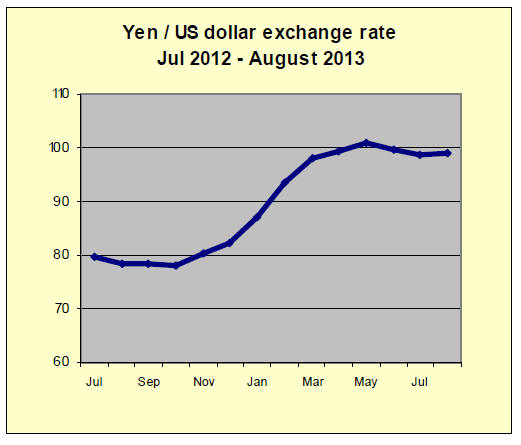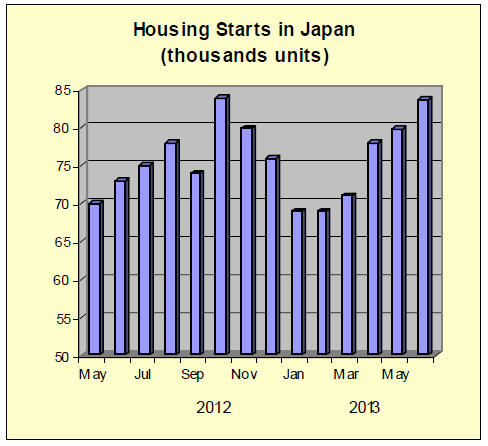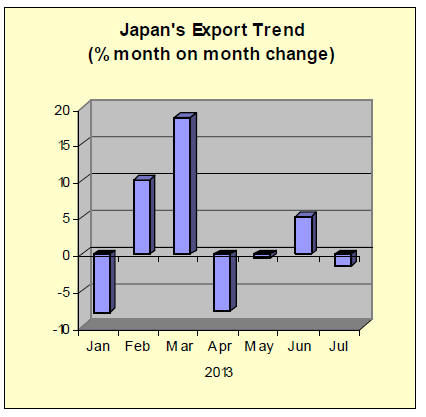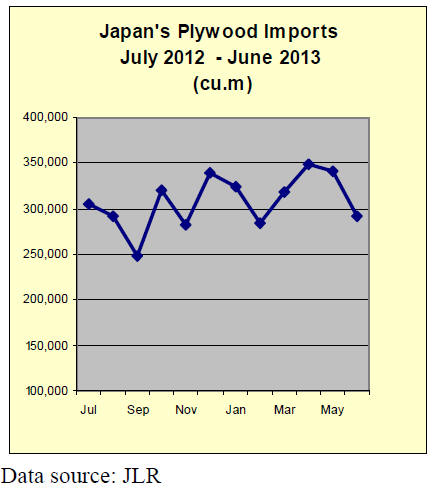Japan Wood Products
Prices
Dollar Exchange Rates of
27th August 2013
Japan Yen 98.35
Reports From Japan
Decision on raising sales tax vital for government credibility
The Japanese government has convened a working group of economists, business
leaders and representatives of consumer bodies to prepare recommendations on
plans to raise the consumption tax to 8 percent in April 2014 from the
current 5 percent.
It has been proposed that a further increase taking the tax to 10 percent
will be introduced in 2015.
The prime minister has said he would make a decision in the autumn when
revised GDP figures for the first half of the year become available and
would take into account the views of the working group just established.
The latest economic data is providing support for the consumption tax rise
but analysts worry that this move would add to household costs at a time
when income growth is stagnant.
Consumer confidence declined in July for the second consecutive month
signalling that most consumers expect prices to increase. Recent data shows
that consumer prices (excluding fresh food) are indeed rising.
Revision of US GDP figures weakens yen
The yen weakened marginally against the dollar in late August after the
US announced revised GDP figures for the second quarter indicating growth
was almost double the initial figure for the quarter.

Cabinet Office sees improvement in Japanese economy
In its August assessment of the Japanese economy the Cabinet Office
concludes that the Japanese economy shows signs of recovery such as:
exports and industrial production are increasing at a moderate pace.
corporate profits are improving, mainly among manufacturers and business
investment is leveling off and shows some movements of
increasing.
Private firms are judging that current business conditions are improving.
the employment situation is improving.
private consumption continues to grow.
recent price surveys indicate that the deflation is ending.
Stronger recovery is expected if increased corporate profits lead to higher
household income and greater corporate investment.
According to the June Short-Term Economic Survey of Enterprises in Japan (Tankan)
by the Bank of Japan, planned business investment in fiscal 2013 is expected
to increase for the third consecutive year for manufacturers, but investment
by non-manufacturers is expected to decline for the first time in two years.
Overall the assessment is that investment is expected to increase for the
second consecutive year.
According to the Business Outlook Survey by the Ministry of Finance and the
Cabinet Office, planned business investment in fiscal year 2013 is expected
to increase both for large manufacturers and large non-manufacturers.
The figures for Orders Received for Machinery, a leading indicator, have
been improving recently.

See
http://www.esri.cao.go.jp/en/stat/juchu/1306juchu-e.html
Housing market supports growth prospects
Housing construction is increasing especially privately owned homes and
houses for rent, overall, construction activity is picking up.

The Cabinet Office says the short-term prospects for house building is
firm with an upward trend supported by work on reconstruction and by an
improvement of the employment and income situations.
However, the construction sector is already reporting a shortage of skilled
workers and the Cabinet Office identifies this as a risk to sustained growth
in the housing sector.
Employment situation improving
The rate of unemployment fell 0.2 percent in June from the previous
month to 3.9%. In June the unemployment rate of those aged 15 to 24 was
6.4%, (down 0.7%)
however, the labor force and the number of employed persons increased.
The ratio of job offers to applicants has been rising because of an increase
in the number of new jobs being created and the data show that overtime
hours worked in the manufacturing industry are rising. These trends need to
translate into rising incomes if the fledgling growth in the economy is to
be supported.
To boost economy, get more women working
Japan's working-age population is projected to fall to about 60 million in
2030 from a peak of almost 80 million in 2000 but it has been estimated that
Japan could add millions to the workforce if the proportion of working women
was lifted to the same level as the average in the OECD countries.
The impact of the added work force would be a boost to the economy, to
household incomes and consumer spending.
The current government in Japan is the first to lay out concrete proposals
for expanding the female workforce as a means to address the declining
workforce without having to expand immigration as this has very little
support across the country.
Exports to major trading partners improve
Japan’s Ministry of Finance released export data on the 19 August
showing July exports fell around 1.6 per cent from June, to yen 5.78
trillion, see:
http://www.mof.go.jp/english/
However, exports rose more that 7% when compared to the performance in July
last year. Exports to the EU improved for the first time in almost two years
growing over 8% as did exports to the US (+15% year on year) and China (+
almost 10% year on year) .

While the weaker yen has given a boost to exports it has led to a nearly
20% jump in the import bill. This increase was largely because of the impact
of oil prices but also, encouragingly, Japanese companies have been
importing manufacturing equipment.
Trade news from the Japan Lumber Reports (JLR)
The Japan Lumber Reports (JLR), a subscription trade journal published every
two weeks in English, is generously allowing the ITTO Tropical Timber Market
Report to extract and reproduce news on the Japanese market.
South Sea (tropical) logs
Log supply season has arrived in the South East Asian countries but actual
log supply in Sarawak, Malaysia continues tight. The reason is depleting
resources.
Log production in the first six months in Sarawak this year was about 20%
less than the same period of last year but the log demand for export and
domestic plywood mills remain firm so that a balance of supply and demand is
way off.
More than 60% of export logs from Sarawak go to India, which reduced the
purchase for a month or so then it restarted buying since late July. To fill
up large size log ships, Indian buyers need to pay high log prices when the
suppliers’ log inventory is low, which influence export log prices for other
markets.
Export log prices at hand on Sarawak meranti regular are holding at $280-290
per cbm FOB. Meranti small are softening at $250. Sabah’s mixed serayah
regular prices are also holding flat at about $270.
Log prices in Japan are firming with high FOB and weak yen. Sarawak meranti
regular prices are 10,100-10,200 yen per koku CIF. Sabah kapur are 13,700
yen.
Facing continuous high log prices, only solution to cover the higher cost is
to keep increasing higher sales prices of plywood.
Plywood
Domestic softwood plywood market continues firm with brisk demand. Shipments
for house builders and precutting plants are active.
June production was 223,200 cbms, the highest in six years and three months
then the shipment was 220,400 cbms. This is nine consecutive months with
monthly shipment over 200 M cbms. The inventory remains low with 129,900
cbms. Thus, undertone is solid.
Only negative factor is delay of construction works because of shortage of
workers, which puts brake on delivery of processed materials.

Plywood mills had to give up price increase on 12 mm 3x6 panel for July
and August after gradual price hike in every month.
In Tokyo metropolitan market, prices of 12 mm 3x6 (special type/F 4star) are
up by 10 yen from July at 940-950 yen per sheet delivered.
Long 9 mm 3x10 prices are flat at 1,370 yen. Thick 24 mm 3x6 prices are
1,910-1,920 yen, 40 yen up from July. Market prices of imported plywood are
weakly holding with high port inventories.
Shipment from warehouses is increasing since last May but heavy arrivals in
April and May over 340 M cbms still remain as negative factor. With this
issue, purchase for futures declined so that the arrivals seem to drop since
August.
Port inventories should decline to balance supply and demand
Market prices of JAS concrete forming 3x6 panels are 1,120-1,130 yen per
sheet delivered, 10-20 yen down from July. JAS 3x6 concrete forming for
coating is 1,220-1,230 yen, 10-20 yen down. 12 mm structural panel prices
are 1,120-1,130 yen, 10-20 yen down and weakening.
|